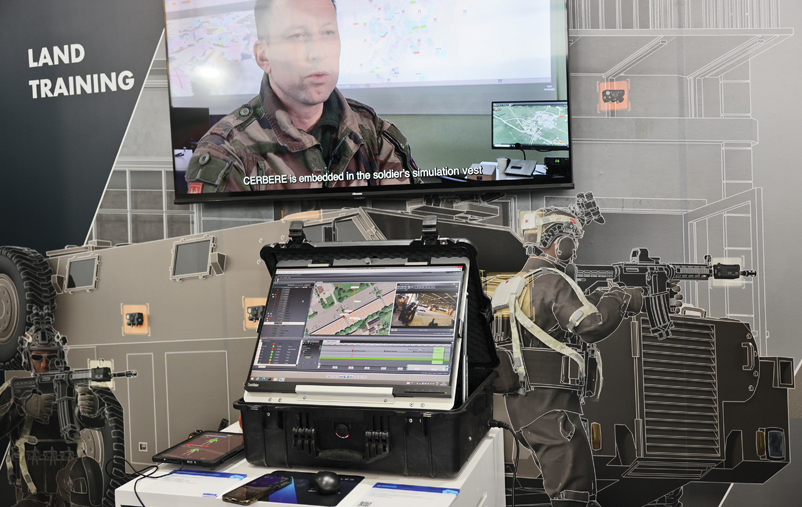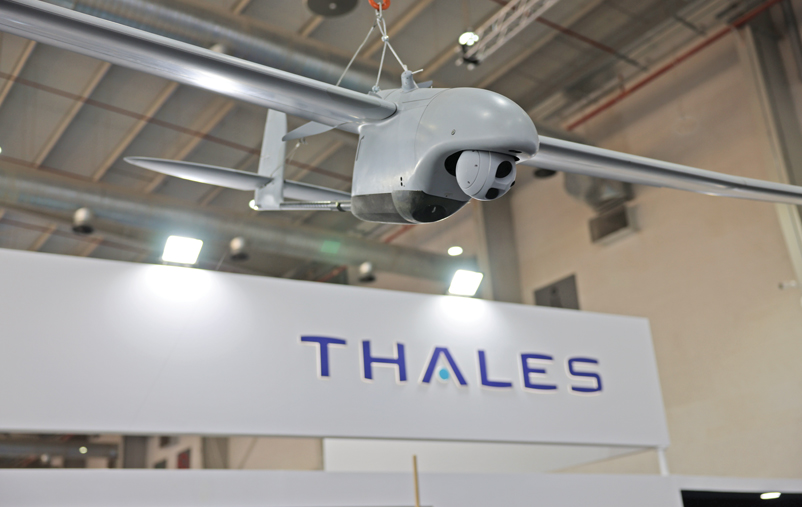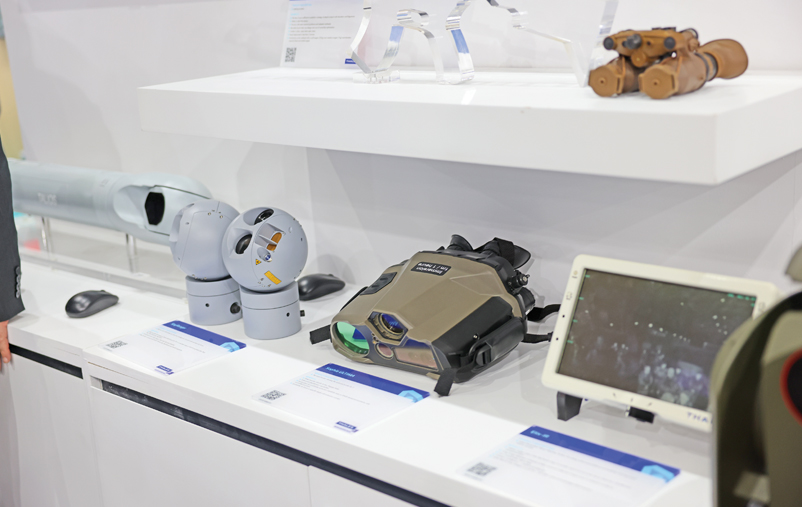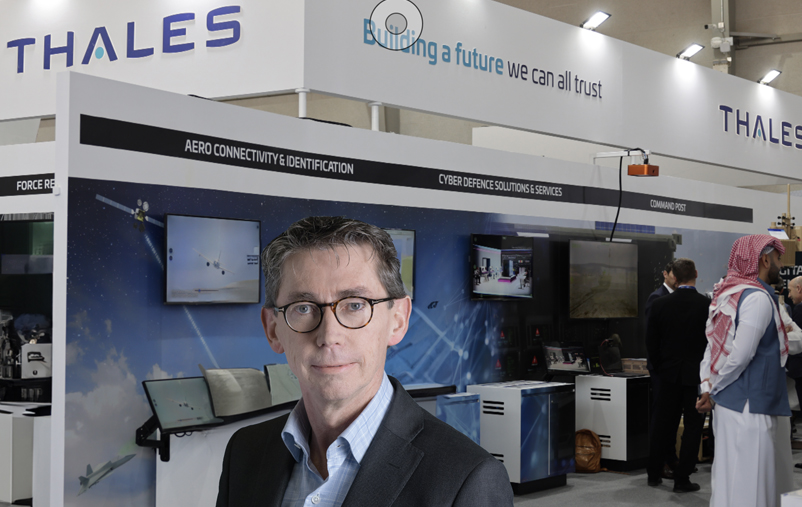Thales is a globally recognized leading company in the fields of technology, security, and defence. With a rich history and extensive experience in various technological domains, Thales provides advanced solutions for both military and civilian sectors.
To get an in-depth understanding of this French company, its areas of expertise, and its latest products, Al Jundi Journal interviewed Mr Herve Dammann, the Executive Vice President of Land and Air Systems at Thales and had the following dialogue with him:

Talk to us about Thales and its fields of work in land and air systems, and the most prominent products it offers its customers.
Thales land and air systems provide our customers with faster detection, deeper understanding for advanced decision-making and more efficient and precise actions. We pioneer advanced, integrated technology that enables military safety and superiority and makes flying safer and more efficient.
Our technologies cover all layers of the airspace. For lower airspace, we developed our Ground-based air defence (GBAD) & drone systems. For instance, Thales offers an integrated Counter Unmanned Aircraft System designed to detect, identify, track and neutralize drones flying in civilian airspace through methods including electromagnetic signal jamming, interception by a swarm of drones and directed energy weapons.
Thales mini UAV Spy’ranger is also part of this lower layer as it can support frontline troops through Intelligence, Surveillance and Reconnaissance (ISR) missions as well as our loitering munitions, TOUTATIS, designed for high-intensity combat.
Then for the short to middle-range solution Thales has developed ForceShield a fully integrated and interoperable combat-proven ground-based Air Defence solution, designed to protect forces, citizens and vital assets against increasingly diverse threats – from low-altitude air threats such as UAS to helicopter, fighter ground attacks or cruise missiles.
Moreover, we have RapidFire, a true multirole defence system. It offers surface-to-air and surface-to-surface capabilities, including the ability to counter micro-UAVs
Furthermore, the Ground Master Multi-Mission All-in-one (GM200 MM/A) is a Multi-mission medium-range radar offering more time-on-target, making it a real game changer for protecting ground assets. The Ground Master 200 Multi-Mission family (GM200 MM) is the new generation of Thales’ medium-range ground radar including Thales 4D AESA technology.
Concerning medium to long range, the SAMP/T integrated collaborative combat system for IAMD (integrated, anti-aircraft and anti-ballistic missile defence) helps protect large areas.
Thales has displayed for the first time, outside France, the IAMD system at World Defence Show, a one-of-a-kind solution that can be adapted to the operational needs of the country to support detection, decision-making and neutralization of threats.
Given that air supremacy is also a matter of tactical and strategic advantage, Thales airborne optronics capability is key. The 2-in-1 targeting & reconnaissance pod TALIOS (Targeting Long-range Identification Optronic System), is an omnirole pod that will enable on-board Artificial Intelligence (AI) to become the best digital partner for fighter pilots.
In the context of evolving threats, it is vital both for the industry and countries to adapt their response to their environment. Thales offers customised solutions to preserve peace and sovereignty for its customers.

What do you think of the evolution of drone technology within the Land and Air Systems department over the years, and what significant advancements do you foresee in the near future?
Aerial drones are a perfect illustration of the two sides (clear and obscure) that characterize the use of many technologies. At one end of the spectrum are drones that operate in a completely legitimate way in the airspace. They are used by official bodies or private individuals, government departments or companies, to carry out different tasks. For example, on the battlefield, drones have demonstrated considerable surveillance and protection capabilities for front-line fighters. Similarly, in the civil field, we are gradually exploring the possibilities of commercial delivery and we already know their role in providing logistical support for surveillance, security or emergency services.
Then we have drones that pose a danger by their mere presence in restricted areas, such as ports or airports, or in restricted airspace. Not to mention drones designed to collect information, drones ignoring all regulations and flying illegally, up to the most malicious uses: armed drones, which pose an obvious threat to populations and infrastructure.
This is why Thales has invested in two distinct areas that affect drone management.
The first is the management of authorized drone traffic. This requires cooperation with all parties concerned, from operators to regulatory aviation authorities. This management must be automated to be able to operate with autonomous and remotely piloted drones, whether granting flight authorizations for automated machines or monitoring the presence of drones operating in lower airspace to avoid the risk of conflicts or even collisions with piloted aircraft. We also need to establish flight paths.
The second is an integrated Counter Unmanned Aircraft System designed to detect, identify, track and neutralize drones to protect sensitive sites such as airports, sports arenas, critical infrastructure and large facilities.
Thales C-UAS solutions offer a clear, simplified view of the situation to protect the airspace in real-time. A variety of drone countermeasures have been designed to provide the right response to the threat depending on the operational context. If the existence of a threat is confirmed, Thales can incorporate a range of technical solutions, including electromagnetic signal jamming, interception by a swarm of drones and directed energy weapons, to neutralize the rogue drone.
Drones have become increasingly integral to military operations, what challenges have you encountered in integrating drone technology into existing land and air systems, and what innovative solutions has your department implemented to address these challenges?
At Thales we can develop new systems with collective intelligence. Leveraging our experience in drones, UAS management systems, surveillance, and aerial operations as well as air defence. We are shaping solutions to integrate drones in the (Air-Land Combat bubble) providing forces with the operational capabilities needed for current and future conflicts.
Operational superiority in high-intensity combat is the result of a combination of manoeuvres involving various platforms, dismounted and embarked units supported by contact UAVs and associated loitering munitions engaged individually or in packs.
By building on innovations such as the Combat Digital Platform, and combining them with secure communications, autonomy services and orchestration, Thales can respond to a crucial issue today: the need to operate several systems at the same time, with a single operator, while being able to react effectively to mission hazards and retaining human control over the machine.
Thales’s ability to propose a universal Command and Control (C2) system to control multiple drone types, secure datalinks and specific payloads for different missions is unique. The Group is agnostic as far as platforms (including drones) are concerned. Our sensors (radars, optronics, etc.), effectors and C2 can be implemented with various solutions according to the needs of the client.
Moreover, High-intensity warfare is characterized by unprecedented violence, significantly increasing the stress levels of combatants and reducing their cognitive abilities. Our systems offer AI-based (hyper-assistants) to enable combatants to understand the situation faster than the enemy does.
Thales Spy’Ranger contact UAV systems offer a concentration of the most innovative technologies available on the market. Spy’Ranger UAVs are used for multi-domain intelligence, reconnaissance, surveillance and protection missions. The armed forces and security forces of several countries, including the French Army (SMDR programme), use them. Interoperable with intelligence and artillery systems, Spy’Ranger drones have become the eyes and ears of armed forces in the collaborative combat of the future. They enable forces to accelerate the OODA (Observe, Orient, Decide, Act) decision loop, i.e. to detect the adversary, anticipate his actions and act before he does.
With the growing use of drones in various sectors, security concerns have become more pronounced. How does your department approach ensuring the security and resilience of drone systems against potential cyber threats and unauthorized access?
Thales is one of the world’s top five players in the cybersecurity market. With the acquisition of 9 companies in 9 years (Imperva, Excellium, S21 Sec, Tesserant, Gemalto, etc.), Thales has strong strategic ambitions to develop its cybersecurity footprint. With a workforce of more than 5,500 cybersecurity experts around the world, revenues are expected to grow from 1.6 to 2.4 billion Euros in 2024.
All Thales solutions are cybersecure by design. With more than 40 years of experience in civil and military air operations, Thales has extensive expertise in command and control, and air defence systems cybersecurity.
Moreover, given the systematic use of communications Jamming GNSS signals, the systems Thales offers are equipped with the latest innovations in communications, navigation and positioning to enable them to survive in the most contested environments.
The datalink system is vital for remotely operated vehicles, enabling operators to control the vehicle and receive live image feeds on land, at sea, or in the air. Thales engineers successfully designed the µTMA, ensuring a compact, lightweight, and energy-efficient solution. This allows for optimal flight capabilities without compromising exceptional data rates and geographic range.
The µTMA is equally impressive when it comes to cybersecurity. To counter enemy hackers’ attempts to intercept the signal to listen to the communications or siphon off the data these threats, all the data transmitted through µTMA is encrypted and communications with the ground station are protected by a stringent identification process.
Moreover, the µTMA is resistant to jamming and has an (anti-replay)system that prevents adversaries from taking control of the drone.

Innovation is crucial for staying ahead in the field of air systems. Can you share some recent innovative solutions or projects that your department has been involved in, particularly those that showcase advancements in air system technology?
Thales Group relies on 130 years of innovation, investing 4 Billion € in R&D every year with 33,000 engineers on a total of 77,000 employees worldwide. Thales anticipates and takes advantage of each major technological shift to develop the best technologies in its fields of operations (radar, radio, medical imaging, cyber, 3-5 semiconductors, trusted AI, etc.).
The Group relies on a common technological base: AI, cyber, connectivity, big data, and quantum computing.
In the air defence domain, through innovation, Thales develops the strongest technologies to secure the skies. Many areas of technological breakthroughs influence the balance of power in this field including digital, end-to-end connectivity, stealth, quantum computing, robotization, hypersonics and weapons with directed effects.
One of the recent innovations I am proud of is the Ground Master 200 Multi-Mission family (GM200 MM). It is the new generation of Thales’ medium-range ground radar including Thales 4D AESA technology.
The GM200 MM exists in two different mobile versions:
The Ground Master 200 Multi-Mission (all in one) (GM200 MM/A) targeting mainly Air Surveillance as well as Ground-Based Air Defence (GBAD) operations (up to low-level Medium Range Air Defence – MRAD).
It maintains the well-known GM200 integrated Command and Control shelter and facilitates space for the radar mast to gain elevation for low-level air surveillance and the two operators onboard.
The Ground Master 200 Multi-Mission (compact) version (GM200 MM/C) is a pallet version offering higher tactical mobility and quicker deployment, as well as specific mission capabilities such as artillery Counter Battery and Weapon Locating. It also suits Very Short and Short Range Air Defence (VSHOR/SHORAD) missions, similar to the GM200 MM/A.
Both versions are easy to transport, optimized for network-centric remote operations, and ultimately save time in planning, training and operation.
The 4D AESA technology is at the heart of these exceptional radars. The digital& software-defined 4D AESA radar technology offers upgrade capacity over the whole life cycle to permanently maintain the tailored operational capability against evolving threats, including enhanced tracking and classification performance.
Looking ahead, what potential applications of drone technology do you find most exciting or promising for the Land and Air Systems, and how do you anticipate these applications shaping the future of military operations?
As the keystone of these future battles, the role of artificial intelligence in defence will only increase, as it sorts through the masses of information gathered, helps analyze situations and proposes a range of decision-making solutions. In short, the aim is to put computing power at the service of humans, who will, of course, remain in the loop and make the final decisions. On this front, Thales, a pioneer in the development of disruptive technologies, has a major role to play, all within a transparent, intelligible and ethical AI approach, named (TrUE AI). All these technological advances offer a new, secure horizon for the protection of sovereign skies.
» Interviewed by: «Al Jundi»













